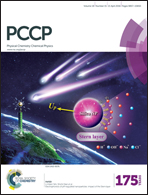Synthesis and thermodynamic study of transition metal ion (Mn2+, Co2+, Cu2+, and Zn2+) exchanged zeolites A and Y†
Abstract
Transition metal cations (Mn2+, Co2+, Cu2+, and Zn2+) containing zeolites A and Y were synthesized by ion exchange and their thermochemistry was investigated by differential scanning calorimetry and high temperature oxide melt solution calorimetry. The enthalpies of formation from oxides for Mn, Co, Cu, and Zn zeolites A range from 14.0 ± 1.3 to 67.6 ± 5.5 kJ mol−1 and those for Mn, Co, Cu, and Zn zeolites Y range from 8.0 ± 2.0 to 32.6 ± 1.8 kJ mol−1. All these zeolites are thus metastable with respect to oxide components and to other dense phases. The formation enthalpies of Mn and Zn exchanged zeolites A and Y are less endothermic than those of corresponding Co and Cu exchanged A and Y. These energetics are consistent with metal oxygen bond lengths and related to crystal field effects of transition metal ions. Similar thermodynamic trends have been seen in transition metal containing spinel, olivine and pyroxene materials. The enthalpies of exchange of transition metals in zeolites A and Y with sodium in aqueous solution are calculated and suggest that these zeolites could be reasonably effective sorbents for heavy metal waste.


 Please wait while we load your content...
Please wait while we load your content...